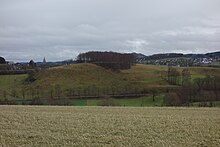Hexenstein nature reserve
The nature reserve Hexenstein with a size of 4.91 ha is located west of Brilon . The Hexenstein was designated as a nature reserve (NSG) by the Arnsberg district government in 1996 . In 2008 the area was again designated as a NSG by the Hochsauerlandkreis with the landscape plan of the Brilon plateau . It is one of 31 nature reserves in Brilon, which belong to the group of limestone peaks with special prohibitions.
Expulsion history
As early as 1985, the Association for Nature and Bird Conservation in the Hochsauerlandkreis (VNV) applied to the Arnsberg district government for the Hexenstein to be designated as a NSG. In 1985, 21 plant species from the then Red List were found in the residual grasslands. These remnants of grassland were on the crest and in the rock area. In 1985 the knoll was also planted with poor grass with beech and larch . It was not until 1996 that the Hexenstein was designated as a nature reserve with other Brilon areas as the Brilon Kalkkuppen nature reserve.
Area description
The NSG is the Hexenstein hilltop . At the top, rocks emerge openly. The Hexenstein itself reaches a height of about ten meters. In addition to a small beech forest, there are grassland areas in the NSG. Grassland also includes grasslands . In 2014, there were only remnants of poor grassland on the rock, on a small area in the beech forest planted in 1985 and on the edge of the path on the western NSG border.
Protection purpose
The NSG is supposed to protect the grasslands in the NSG. As with all nature reserves in Germany, the protection designation pointed out that the area became a nature reserve “because of the rarity, special character and beauty of the area”.
Prohibitions
In addition to the normal prohibitions in nature reserves, the NSG Hexenstein, like the other 30 limestone peaks, has additional prohibitions. It is forbidden to fertilize, roll and drag the Brilon limestone tops. No more than two livestock units per hectare may graze at the same time. Furthermore, mowing is only permitted from July 1st of each year.
Protective measures
At the beginning of 2012, the red spruce trees were removed from the NSG by a forest company under the supervision of the Biological Station Hochsauerlandkreis . These spruce trees were planted around 1965 on poor grass in what is now the NSG. In the landscape plan from 2008, the removal of "non-local, non-native trees" was planned. Since the cleared part of the area was later to be used as grassland, the branch material was also cleared from the area and the tree stumps milled off. The former forest area was then fenced in. The EU bore a large part of the costs . Almost the entire NSG has been grazed since 2014.
In order to carry out nature conservation measures in the area, the state of North Rhine-Westphalia bought larger areas in the NSG. VNV bought more space.
See also
literature
- Hochsauerlandkreis - Lower Landscape Authority: Landscape plan Brilon plateau . Meschede 2008, p. 90.
- Harald Legge, Richard Götte: Redevelopment of species-rich poor grassland - defrost on two nature conservation areas. Irrgeister 2012/20, pp. 34–35.
References
- ↑ Hochsauerlandkreis - Lower Landscape Authority, Landscape Plan Briloner Plateau, Meschede 2008, p. 60.
Web links
- "Hexenstein" nature reserve (HSK-536) in the specialist information system of the State Office for Nature, Environment and Consumer Protection in North Rhine-Westphalia
Coordinates: 51 ° 23 ′ 42 ″ N , 8 ° 32 ′ 24 ″ E



